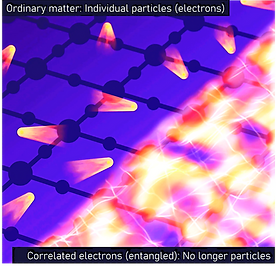Research
Primary areas of interest
Exotic symmetries in superconducting hybrids
Superconducting hybrids offer a surprisingly effective tool to study exotic quantum states, which are extremely hard to find in nature. To do this, we utilize the macroscopic wavefunction of a superconductor, and modify its symmetry using concepts such as topology and exchange interactions, found in other materials. With a bit of creativity and cutting-edge nanofabrication, you can turn an ordinary superconductor into a wide range of exotic quantum states. A prime example of such states is the odd-frequency spin-triplet pairing state: A class of allowed symmetries for bosonic condensates, which has never been observed to occur by itself in nature. Luckily, however, we can create and study this symmetry using carefully-designed superconductor-ferromagnet hybrid systems. Apart from their rich physics, the triplet correlations offer a unique opportunity to combine spintronics with the absence of decoherence and dissipation in superconductors. Recently, we developed a new type of superconducting memory element, where the data (0 and 1) is stored in the bistable spin-texture of a Josephson junction. Currently, we are exploring the rich non-equilibrium phenomena, which emerge when a condensate of spin-triplet pairs is excited through magnetic resonance at GHz frequencies.

Strongly-correlated electrons
What does transport look like in a system of many particles, which are all entangled with each other through strong (long-range) correlations? This is arguably one of the most profound questions in modern physics. It also points to a surprising link between blackholes, high-temperature superconductors, and quark-gluon plasma – resulting in an unexpected synergy between these research fields. So, what’s the link? The link, is that each case represents an irreducible many-body entangled problem with no “special” ground state. Such problems cannot be solved by (semi-)classical approximations and perturbation theory: our usual approach to describe matter (e.g., electrons in a periodic lattice).
